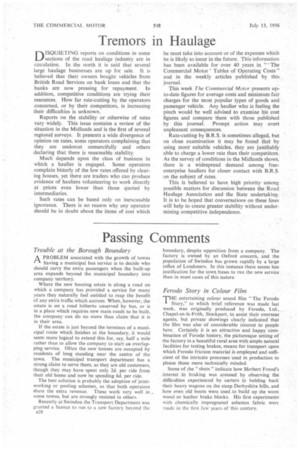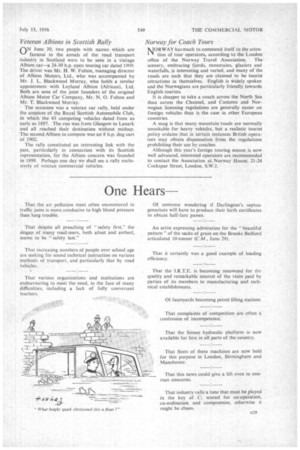Passing Comments
Page 34

Page 35

If you've noticed an error in this article please click here to report it so we can fix it.
Trouble at the Borough Boundary
APROBLEM associated with the growth of towns having a municipal bus service is to decide who should carry the extra passengers when the built-up area expands beyond the municipal boundary into company territory_
Where the new housing estate is along a road on which a company has provided a service for many years they naturally feel entitled to reap the benefit of any extra traffic which accrues. When, however, the estate is on a road hitherto unserved by bus, or is in a place which requires new main roads to be built, the company can do no more than claim that it is in their area.
If the estate is just beyond the terminus of a municipal route which finishes at the boundary, it would seem more logical to extend this for, say, half a mile rather than to allow the company to start an overlapping service. Often the new houses are occupied by residents of long standing near the centre of the town. The municipal transport department has a strong claim to serve them, as they are old customers, though they may have spent only 2d. per ride from their old home and now he spending 6d. per ride.
The best solution is probably the adoption of jointworking or pooling schemes, so that both operators share the extra revenue. These work very well in some towns, but are strongly resisted in others.
Recently at Swindon the Transport Department was granted a licence to run to a new factory beyond the B28 boundary, despite opposition from a company. The factory is owned by an Oxford concern, and the population of Swindon has grown rapidly by a large influx of Londoners. In this instance there seems less justification for the town buses to run the new service than in most cases of this nature.
Ferodo Story in Colour Film
THE entertaining colour sound film "The Ferodo Story," to which brief reference was made last week, was originally produced by Ferodo, Ltd., Chapel-en-le-Frith, Stockport, to assist their overseas agents, but private showings clearly indicated that the film was also of considerable interest to people here. Certainly it is an attractive and happy combination of Ferodo history, the picturesque setting of the factory in a beautiful rural area with ample natural facilities for testing brakes, means for transport upon which Ferodo friction material is employed and sufficient of the intricate processes used in production to please those more technically minded.
Some of the " shots " indicate how Herbert Frond's interest in braking was aroused by observing the difficulties experienced by carters ip holding back their heavy wagons on the steep Derbyshire hills, and how even old boots were used.to build up the worn wood or leather brake blocks. His first experiments with chemically impregnated asbestos fabric were made in the first few years of this century_
Veteran Albions in Scottish Rally
nN June 30, two people with names which are
famous in the annals of the road transport industry in Scotland were to be seen in a vintage Albion car—a 24-30 h.p. open touring car dated 1909. The driver was Mr. H. W. Fulton, managing director of Albion Motors, Ltd., who was accompanied by Mr. J. L. Blackwood Murray, who holds a similar appointment with Leyland Albion (African), Ltd_ Both are sons of the joint founders of the original Albion Motor Car Company, Mr. N. 0. Fulton and Mr. T. Blackwood Murray. The occasion was a veteran car rally, held under the auspices of the Royal Scottish Automobile Club, in which the 43 competing vehicles dated from as early as 1897. The run was from Glasgow to Lanark and all reached their destination without mishap. The second Albion to compete was an 8 h.p. dog cart of 1902.
The rally constituted an interesting link with the past, particularly in connection with its Scottish representation, for the Albion concern was rounded in 1899. Perhaps one day we shall see a rally exclusively of veteran commercial vehicles.
Norway for Coach Tours
NNORWAY has much to commend itself to the attention of tour operators, according to the London office of the Norway Travel Association. The scenery, embracing fjords, mountains, glaciers and waterfalls, is interesting and varied, and many of the roads are such that they are claimed to be tourist attractions in themselves. English is Widely spoken and the Norwegians are particularly friendly towards English tourists.
It is cheaper to take a coach across the North Sea than across the Channel, and Customs and Norwegian licensing regulations are generally easier on foreign vehicles than is the case in other European countries.
A snag is that many mountain roads are normally unsuitable for heavy vehicles, but a realistic tourist policy ordains that in certain instances British operators may obtain dispensation from the regulations prohibiting their use by coaches Although this year's foreign touring season is now well advanced, interested operators are recommended to contact the Association at Norway House, 21-24 Cockspur Street, London, S.W.1.












































































































